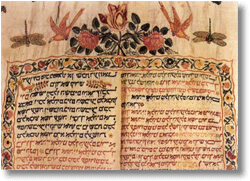| |
 Not One Jot
Not One Jot
or Tittle
Numbers are very symbolic in the Bible. Take seven for example. It represents God�s complete provision. There are seven days in a week, seven articles of furniture in the tabernacle, seven eyes on the stone in Zechariah 3:9 upon which God engraves an inscription, seven churches, golden lampstands and stars in Revelation 1-3, seven spirits (Rev. 4:5), seven seals (Rev. 5:1), seven angels with seven trumpets (Rev. 8), seven thunders (Rev. 10:4) and seven last plagues (Rev. 15).
In Kevin Acre�s draft article, Data Integrity Patterns of the Torah, he presents numerous intriguing types of evidence that the total number of letters in each of the books of the Torah are exactly what they originally were. This could be seen as support for the belief that the Torah has been copied virtually without error down through dozens of centuries until this very day. If such were the case, the integrity of Torah codes would stand on a much firmer basis than if there were known copying errors. Incidentally, Kevin is the developer of the popular code search program, Codefinder. He lives outside of Melbourne, Australia.
Given the importance of sevens, we should stand up and take notice when Kevin tells us that the total number of letters in the book of Genesis (78,064) is the same as
77,700 + (7*7*7) + (7+7+7).
That�s quite neat.
Now, three is another key number. There is the Trinity of the Father, Son and Holy Spirit, and the unholy trinity of the world, the flesh and the devil. The trinity of blessing is grace, mercy and peace. Jesus spent three days and three nights in the heart of the earth between His crucifixion and resurrection, a parallel to the three days and three nights that Jonah spent in the belly of a whale (Matthew 12:39-40).
Notice that in the formula above there are three terms, each with three sevens in them. Impressive.
Kevin also notes that the gematria sum for the letters in the book of Deuteronomy is 3,777,010, a number including a three and three sevens. (Gematria is based on assigning a number to each letter in the Hebrew alphabet, with one through nine assigned to the first nine letters, respectively, ten through ninety to the next nine letters, and one hundred through four hundred to the remaining final four letters). In the past BCD has avoided reference to gematria because there is more than enough to investigate regarding Bible codes, and there is a need for us to keep a tight focus. However, we made an exception in the case of Kevin�s article because it uses gematria to support a key assumption behind the purported validity of Bible codes.
Finally, twelve is also an important number in the Bible. There are the twelve tribes of Israel, the twelve spies who surveyed the Promised Land, the twelve stones in the breastplate of the high priest, the twelve disciples of Jesus, and the twelve gates to Jerusalem.
So, what if the number of letters in some other books in the Torah can be expressed as the result of the sums and/or products of threes, sevens and twelves? Kevin notes that 3*3*7*7*12*12 equals 63,504, which is quite close to the 63,529 letters in Exodus and the 63,532 letters in Numbers. He then observes that the number of letters in Exodus can be obtained by adding to 3*3*7*7*12*12 the sum of the digits in the number of letters in Genesis (7+8+0+6+4 = 25). Also quite neat. But then he also notes that the number of letters in Numbers can be obtained by adding to 3*3*7*7*12*12 the sum of the digits in the number of letters in Deuteronomy (5 + 4 + 8 + 9 + 2= 28), if one includes two inverted Hebrew letters (Nun) in the letter count. Given this, the formulae for the total number of letters in Exodus and Numbers are mirror images of one another, reflected off the third book.

Acres notes that in the Sepher Yetzirah (Book of Creation), a text attributed by tradition to Abraham, three numbers are of key significance (3, 7 and 12), paralleling the structure of the Hebrew alphabet, which has 3 mothers (Alef, Mem and Shin), 7 doubles (Bet, Gimel, Dalet, Kaf, Peh, Resh and Tav) and 12 elementals.
Kevin also notes that three, seven and twelve are prominent in two formulae for a close approximation of pi:
(3+7+12)/7 = 3.142857,
and a close approximation of pi to the fourth power:
3*3*3*3 + {(12+7)/(3+7+12)}.
For many centuries Jewish scribes have painstakingly copied the Torah, believing that dire consequences would follow if any kind of copying error were made. This concern was based on the ancient belief that God dictated the Torah to Moses on Mount Sinai letter-by-letter and that the entire history of the world, past, present and future are encoded in the Torah. Perhaps the words of Jesus relate to this: �For verily I say unto you, Till heaven and earth pass, one jot or one tittle shall in no wise pass from the law, till all be fulfilled.� (Matthew 5:18)
Checksums
Did God build in bits of evidence to demonstrate that the Torah was error-free? Kevin sees examples such as those cited in this review as candidates for such evidence. And his paper provides many other similar evidences, which may well be divine checksums. He illustrates what checksums are through several contemporary examples.
If you write a document and send it via e-mail, how do you know the message arrived at its destination uncorrupted by error? In the computer age, it is simple. You just need to create a checksum for the file you are sending. If the checksum of the received file does not match that of the sent file, then you know something has gone wrong.
What most people do not realize is that every packet of information sent via the internet has a checksum, the same as each and every sector on the hard drive of your PC. Checksums are those invisible attributes which monitor the integrity of nearly every operation you perform on your computer.
Checksums count the values of each character in a computer file so the file can later be checked to ensure that it conforms to its original checksum. Variances do exist in implementations but the purpose is the same. In the computer age, checksums are the unseen guardians of data integrity.
More than 3,500 years ago, the luxury of computers did not exist so what could you have done if you planned to write a document which had to be completely error free. Your only option was to use known mathematical markers in the hope that someone down the line would pick up on them and recognize them. You could perhaps use several different schemes concurrently just to prove without a doubt that the content was correct at a later date.
Closing Thoughts
The observant reader at this point should be wondering what elegant formula was found for the number of letters in Leviticus. Kevin presents this one:
1*(6^1) + 2*(6^2) + 3*(6^3) + 4*(6^4) +5*(6^5).
Although this one doesn�t focus on threes, sevens or twelves, it does represent a very neat progression of terms.
Kevin also found the following elegant formula for the number of letters in Exodus:
(5^1) + (6^2) + (7^3) + (8^4) + (9^5) = 63,529.
In this formula, both the base numbers and the exponents progress upward by one for each successive term.
Kudos to Kevin for introducing a whole new field of inquiry related to Bible codes. We have made his entire paper available on our site. Perhaps it will spur other BCD readers on to discover additional evidences that could be shared with everyone in some future BCD issue.
A fair amount of Kevin�s number research was conducted with the help of the On-Line
Encyclopedia of Integer Sequences.
In further investigating this area, it would be intriguing to know whether or not similar evidences could be found for the number of letters in each book, plus or minus one, or two, or three, etc. A dearth of examples, after applying a comparable amount of research to Kevin�s, would be quite interesting.
Return to First Page
Copyright �2004 biblecodedigest.com
All Rights Reserved
The Bible Code Digest is a publication of the Isaac Newton Bible Code Research Society. No part of this newsletter may be reproduced or used in any form or by any means, electronic or mechanical, including photocopying, recording, or by any information sTorahge or retrieval system, without permission in writing from the publisher. Subscribers may forward to one recipient without seeking permission from the publisher.
The Bible Code Digest is published by a group of scientists and writers dedicated to a search for the truth. Our goal is provide accurate, unbiased reporting of news about cutting edge Bible code research conducted by our own group as well as by other credible researchers. We endeavor to report on the significant findings of Jewish, Christian and secular researchers, regardless of their views regarding the potential validity of some Bible codes. We present a variety of viewpoints on Bible codes and often accompanying spiritual matters in these web pages, but we don't necessarily agree with all of them. Our view is that God created codes in the Bible because He loves us and wants to show us another facet of His omnipotence and omniscience.
Inquiries may either be addressed to Dave Swaney, Editor, or Ed Sherman, Director, at BibleCodeDigest.com, [email protected].
See you next month with much more about Bible Codes.
|
Enjoy finding your own Bible codes.
Bible code search software is available in our online store.
Subscribe Free! Sign Up Today!
Become a member of the non-profit Isaac Newton Bible Code Research Society.
Not only will you be part of the world's leading organization researching and publicizing Bible and Torah codes, but you will receive Bible Code Digest absolutely free, including . . .
- Latest Bible Code News
- Easy-to-Understand Bible Code Feature Articles
- Exciting Inside Information from Leading Code Researchers
- Details of Great New Discoveries
- Summaries of the Latest Battles Between Code Proponents and Skeptics
Stay current on Bible code news. Be first to hear about all of the latest Bible code discoveries.
Sign up to receive Bible Code Digest today.
|
|







Click here
and sign up to receive Bible Code Digest with no cost or obligation.
 Code Skeptics' Arguments Trashed Ever since the first Bible codes were announced, skeptics have been saying, "Oh, well, you can also find codes like that in books like War and Peace and Moby Dick."
We took the time to examine this notion and the best example of it that the skeptics have been able to come up with. The results of our research have completely blown away their theory.
Click here to see for yourself.
NEW: Second Study Undermines
Skeptics' Main Objection
to Codes
Click here for report |











